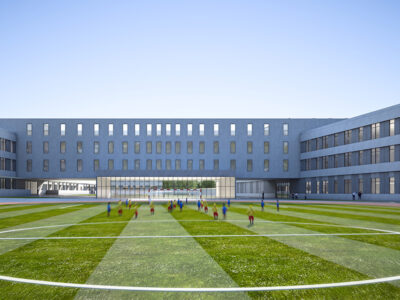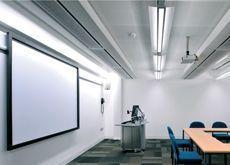In the Middle East, the air-conditioning equipment that is essential for providing a comfortable internal climate for pupils in schools can also have a massive effect on the acoustic comfort, unless carefully selected.
Acoustic comfort is arguably the most important requirement of an educational facility. Being able to understand what a teacher is saying is essential to student learning. Education projects are designed to utilise a variety of different environments, invariably with different acoustic demands. Quite often only 50% of the plan area needs acoustic treatment – it is all about specifying the right product without inhibiting design aesthetics and ensuring product durability, says Lianne Peters of SAS International.
Both external noise and classroom ‘babble’ can affect the performance of students undertaking verbal and non-verbal tasks in the classroom. The introduction of a school grading system by Dubai’s Knowledge and Human Development Authority (KHDA) has increased the focus on such pupil performance, with the KHDA’s inspection report becoming key to many parents’ choice of school. This, in turn, may have a large financial impact on certain schools within the region’s primarily paid-for education system.
The problem of noise in schools has increased steadily, with contributing factors including changes in teaching practices, the use of electrical equipment and increasing class sizes. School premises comprise a range of demanding acoustic environments, each with different acoustic challenges. Circulation spaces such as corridors and stairwells can be a source of increased sound reverberation, creating high levels of noise during busy periods. These areas require treatment with sound-absorbent material, which helps reduce acoustic reverberation.
Acoustic baffles and cross-talk attenuators can be designed and installed between classrooms and corridors. Both solutions provide natural cross-flow ventilation, while minimising sound travelling from room to room, thus controlling regenerated noise. In classrooms, durable surface finishes are hard and therefore reflect sound easily. Reflected sound increases the reverberation time of the space, making speech less intelligible and learning difficult.
Acoustic lighting rafts
Acoustic lighting rafts can be used to meet specific illuminance levels and acoustic requirements. Sound passes through the perforated face of the raft before being absorbed by an acoustic pad. Any sound not absorbed by travelling through the face of the raft but reflected on the structural soffit is absorbed by an additional pad. When used in conjunction with an open soffit, rafts also enable the thermal mass of the structure to be exploited for thermal mass heating and cooling.
Music rooms in schools present an acoustic challenge due to longer reverberation times. Sound levels created by musicians must not be allowed to interfere with surrounding rooms. For recital or performance rooms, the UK Building Bulletin 93 (BB93) suggests a reverberation range of between 1.0 and 1.5 seconds, with an outdoor ambient noise level of no more than 30 dB. The performance for sound insulation between such rooms must have a sound reduction index (Rw) of not less than 45 dB.
Room-to-room attenuation can be achieved using a metal ceiling manufactured to 49 dB. The durable perforated metal ceiling can contain backing pads, acoustic fleece and backing board to meet acoustic requirements. Aesthetic demands need not be sacrificed when specifying acoustic solutions to meet important acoustic legislation. The flexibility of acoustic products allows architects increased design flexibility and durability when considering acoustic settings within the education sector. For further information visit
www.sasint.co.uk
.







